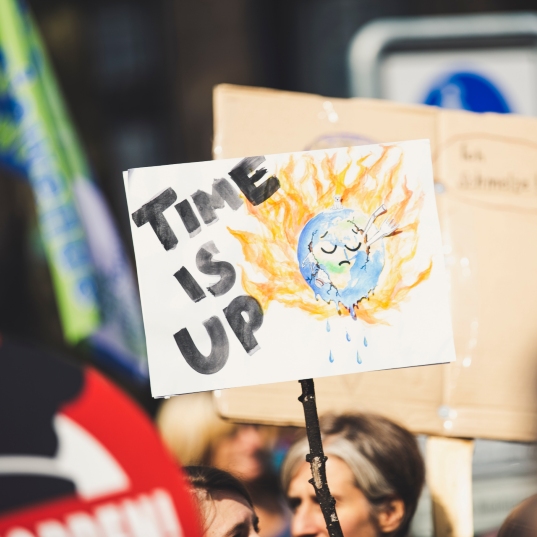Conclusions from COP26: the challenge of doing away with coal
We need urgent and effective action against climate change, and COP26 was found wanting when it came to tackling the climate crisis
Glasgow seemed like humanity’s last chance in the fight against climate change. The United Nations Conference of the Parties on Climate Change (COP), held in the United Kingdom over the past two weeks, had one main goal: to keep alive the aim of limiting the warming of the planet to 1.5°C.
Did COP26 in Glasgow come up with the great international agreement we hope for? Let’s analyze the good and the bad from the event.
What you’ll find in this article
- The final agreement from COP26 in Glasgow
- The good news from COP26
- The issues still pending from COP26
The final agreement from COP26 in Glasgow
 It was inevitable that the final agreement reached by the parties would leave us with mixed feelings. Although countries were lobbied hard to speed up the progressive elimination of coal and fossil fuel subsidies, they only came up with weak wording vis-à-vis the future and without an effective plan to help us tackle the problems we are now experiencing from climate change.
It was inevitable that the final agreement reached by the parties would leave us with mixed feelings. Although countries were lobbied hard to speed up the progressive elimination of coal and fossil fuel subsidies, they only came up with weak wording vis-à-vis the future and without an effective plan to help us tackle the problems we are now experiencing from climate change.
Countries agreed only to “phase down” and not “phase out” coal, due to a last-minute edit by China and India. Nonetheless, the agreement does demand the progressive elimination of inefficient subsidies for fossil fuels. The milestone here is that this is the first time these measures have been included in a UN agreement affecting 196 countries.
And, despite the inclusion of a plea to harden plans to cut greenhouse effect emissions by the end of 2022, only a handful of world leaders showed themselves to be ready to put forward concrete actions. Although the Paris agreement established 2025 as the date by which more ambitious measures had to be presented, the planet now urgently needs to achieve carbon neutrality.
Current plans, as published by the United Nations Environment Programme (UNEP), will lead to a warming of between 1.8°C and 2.1°C, according to the latest analysis of commitments. The global temperature has already risen by more than 1.1°C and reducing emissions is vital if the increase is to remain between 1.5°C and 2°C with respect to pre-industrial levels.
DESTACADO: “In the conclusions, the Parties agreed to revise their commitments as necessary before the end of 2022 to get us back on the path of 1.5°C.”
The good news from COP26
Human beings have demonstrated on various occasions their ability to tackle unimaginable catastrophes, of which the coronavirus crisis is the latest in a long list. If we were able to tackle the pandemic through science, technology and urgent regulatory measures, we can also do so in the fight against climate change. And this is the feeling raised in a series of announcements from COP26 which lead us to be optimistic.
- Collaboration between China and the US: one of the most surprising announcements at the Glasgow summit was the agreement between the two biggest CO2 Their joint declaration says both nations will work together to reduce emissions, moving toward a clean energy model and decarbonization.
- The Global Methane Pledge: 100 countries agreed to reduce their methane emissions by 30% by 2030, an important step when you take into account that the IPCC said in its latest report that between 30% and 50% of the increase in temperatures is due to this greenhouse gas. Read more about it in this article.
 Regeneration of forests: deforestation was to the fore in one of the major agreements coming out of Glasgow. Over 100 countries (in which 90% of the world’s forests are concentrated) have committed not only to stop deforestation, but to reverse it.
Regeneration of forests: deforestation was to the fore in one of the major agreements coming out of Glasgow. Over 100 countries (in which 90% of the world’s forests are concentrated) have committed not only to stop deforestation, but to reverse it.
- The Glasgow Agenda: the launch of the Glasgow Breakthrough Agenda signifies a commitment by some 40 governments to promote clean energies and reduce emissions in some of the planet’s most polluting industries: those of steel, hydrogen, energy and transport. The signatories agree to widen the implementation of climate policies, but for now have not defined how or when this promise will be translated into their national plans. The terms “loss” and “damage” have been accepted. Although these are yet to be defined, it opens the door to lawsuits against countries and companies that have most contributed to climate change.
- The Paris Agreement Rulebook: after six years of work, the Paris Rulebook has finally been adopted and with it the Article 6 mechanisms establishing the functioning of international carbon markets, support for greater global cooperation in reducing emissions, a framework for transparency and the deadlines for national contributions.
- Investment in fossil fuels ends: more than 30 countries committed to ending financing the purchase of fossil fuels as of 2022, among them France, Germany and Spain.
- Global Coal to Clean Energy Transition: the global pact, supported by more than 40 countries, promises to eliminate the use of coal in the main economies by 2030 and in developing countries by 2040.
- Sale of polluting vehicles to end: 100 entities launched a new global pact to strengthen zero emission policies before 2030 and end the sale of cars and vans with combustion motors in the principal markets by 2035 and at global level by 2040.
- Fashion industry: over 130 companies and 40 organizations connected to the fashion industry launched a joint appeal for a 50% reduction in emissions in their activities by 2030.
- Indigenous peoples: the United Kingdom, Norway, Germany, the US, Netherlands, and 17 US donors, promised to support indigenous communities with direct financing. A total of 1.5 billion euros will go to protecting forests and protecting and developing local communities.
Issues pending from COP26
What was conspicuous by its absence in Glasgow? Unity against climate change, among the countries and organizations attending, and the approval of more urgent and resounding measures for managing the climate crisis. The biggest let-downs at this summit concerned:
- Climate finance: a great step is taken but without the commitment as a requirement. The agreed text urges, does not commit, developed countries to doubling collective financing for adaptation to climate change, with an objective of 100 billion dollars a year for 2021-2025, reaching this 100 billion dollar target as soon as possible. The parties have also committed to beginning a process to agree on long-term financing (beyond 2025).
- Elimination of coal, and subsidies for fossil fuels: the final version of the agreement talks about a phase-down, a progressive reduction, a measure that will not be enough to achieve the aim of limiting the temperature rise to 1.5°C.
There are those who conclude that this summit was a success. Others who declare it was a failure. The only certainty is that the time is running out for humanity to move from words to deeds.
Sources:
https://www.nytimes.com/es/2021/11/06/espanol/cop26-resumen.html
https://www.un.org/es/climatechange/todo-lo-que-necesitas-saber-sobre-la-cop26
https://www.elmundo.es/ciencia-y-salud/medio-ambiente/2021/11/14/6190c0d5e4d4d8f63a8b45c1.html

